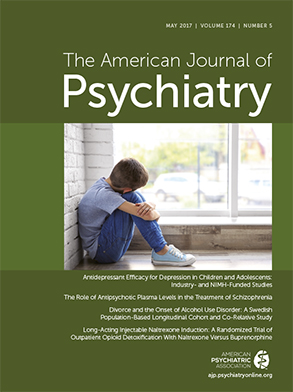To those of us who were treating depression 30-plus years ago, it always seemed a cruel irony that the group of patients at highest risk for suicide by overdose or other means were prescribed medications—tricyclic antidepressants and monoamine oxidase inhibitors (MAOIs)—that were among the most lethal agents in all of medicine. From the beginning of antidepressant therapies, a major goal has been to have safer, less lethal medicines to treat these potentially lethal diseases. With the emergence of the second generation of antidepressants, starting with fluoxetine 26 years ago, there was a collective sigh of relief because the newer antidepressants were indeed less lethal in overdose compared with older agents. Furthermore, some, but not all, meta-analyses found that prescribing antidepressants reduces suicide attempts (
1,
2). Other studies supported the effectiveness of lithium (
3) and antiepileptic mood stabilizers (
4) in bipolar disorder. Together, these findings suggested that psychopharmacology could mitigate the risk of suicide in our patients with relative low risk.
However, data from the Centers for Disease Control and Prevention found that the risk of death by drug overdoses is actually increasing (
5). This finding indicates that prescribers should be aware of the risks associated with medications administered to patients who are at risk for suicide.
A study from the United Kingdom evaluated self-poisoning in six hospitals (
6). Using the ratio of deaths to prescriptions and the ratio of deaths to nonfatal overdoses, tricyclic antidepressants, venlafaxine, mirtazapine, and citalopram were associated with increased risk (
6). White et al. used the U.S. National Poison Data System (NPDS) to review 82,802 ingestions of a single agent in overdoses from 2000 through 2004 (
7). Antidepressants with high hazard ratios included amoxapine, maprotiline, tricyclic antidepressants, MAOIs, and bupropion. Selective serotonin reuptake inhibitors (SSRIs) as a group had lower hazard ratios. The study by Nelson and Spyker (
8) in this issue used the same database but included 962,222 single drug exposures between 2000 and 2014. The authors computed a morbidity index as serious outcomes per 1,000 exposures and a mortality index as fatal outcomes per 10,000 exposures. Their results were remarkably similar to the results of Hawton and White. Morbidity indices were high for lithium, quetiapine, olanzapine, and bupropion; mortality indices were highest for lithium, quetiapine, olanzapine, ziprasidone, bupropion, venlafaxine, valproic acid, carbamazepine, and citalopram. Similar to the other studies, tricyclic antidepressants and MAOIs were associated with greater morbidity and mortality.
Nelson and Spyker’s findings cannot tell us the actual risk associated with the different medications in the real world. Reporting to the NPDS is optional, and it is unclear how that information reflects the relative use of the different agents. Important information, including the dosage ingested and whether the patient was actually prescribed and taking the drug at the time of ingestion, is not available. On the other hand, patients are followed-up by telephone by NPDS staff, which means that the calculations of morbidity and mortality probably indicate the relative safety of the medications. It is also important to consider that the assignment to drug is not random. It is plausible that certain medications are perceived as more effective and more likely to be prescribed for patients at risk for suicide.
Notwithstanding the limitations inherent in a study like this, what are the clinical implications of these data? First, despite the relative greater safety of newer antidepressants, morbidity and potential mortality associated with these agents continue to be public health and clinical concerns. The data in the Nelson and Spyker article also remind us of the substantial risks associated with other psychotropic medications, such as antipsychotics and mood stabilizers. These risks are compounded by almost universal practices in the insurance industry: namely, the requirement of 1-month (for acute) and 3-month prescriptions. Smaller amounts of medications may be prescribed but would be subject either to nonpayment by insurance or to higher copayments for the patient. Therefore, prescribing medications 1 week at a time is difficult and verges on the impossible. Ingestion of a 1-month supply of many psychotropic medications, especially tricyclic antidepressants, can easily be lethal.
Second, the data from this study highlight the substantial differences in toxicity across medications, even within the same class, such as SSRIs. Thus, within the SSRI class, a wise clinician might avoid citalopram or fluvoxamine in a patient with a substantial risk of overdose. Differences across classes are even more dramatic. In addition, the data make clear the greater morbidity and mortality associated with serotonin-norepinephrine reuptake inhibitors (SNRIs) and bupropion, compared with SSRIs.
Third, despite the clear evidence of substantial morbidity and mortality associated with overdose of modern antidepressants, this study confirms and highlights that these newer agents are dramatically safer than older agents such as tricyclic antidepressants and MAOIs. As a stark example, in this study, desipramine was 157 times as lethal as sertraline (see Table 1 in the article). Tricyclic antidepressants as a class have a morbidity index that is almost 10 times higher than that of citalopram, the most dangerous of the SSRIs, and that is almost six times higher than that of SNRIs and bupropion. This information should provide some comfort to clinicians.
Finally, these data should remind us of the clinical tricks that many of us developed during the tricyclic era when all of our antidepressants were easily lethal in overdose. These include: having a significant other or parent, spouse or partner, or an adult child keep psychotropic medications hidden and disburse the medication no more than every 3 to 4 days, or having the therapist (if the psychiatrist is practicing pure medication management) keep the 1-month supply and disburse 1 week of medications at a time.

